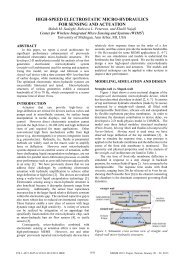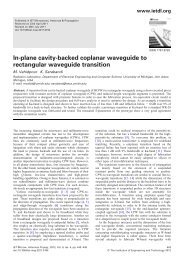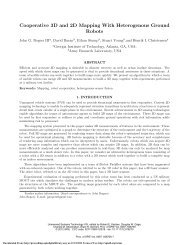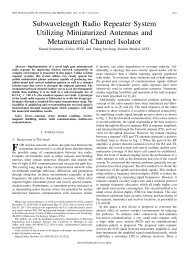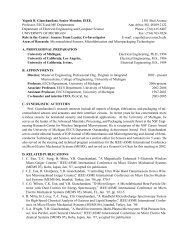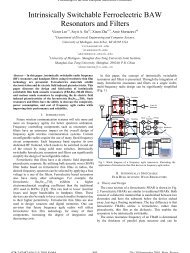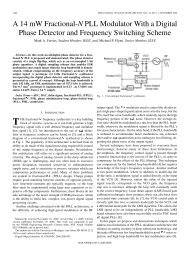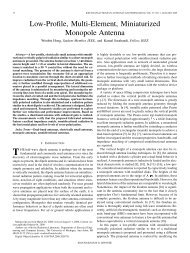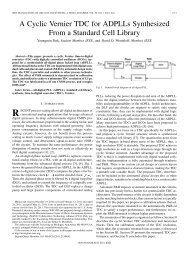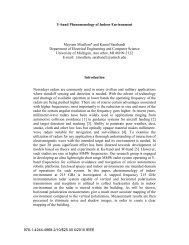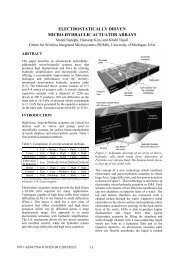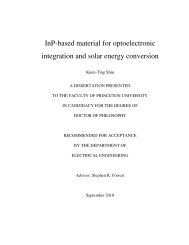- Page 1 and 2: SQUARAINE DONOR BASED ORGANIC SOLAR
- Page 3 and 4: DEDICATION To my two sons Anderson
- Page 5 and 6: characterization of crystallized sq
- Page 7 and 8: Chapter 3 Efficient and ordered squ
- Page 9 and 10: List of Publications, Conference Pr
- Page 11 and 12: Figure 1.10: Molecular structure of
- Page 13 and 14: shown in (d), which correspond to t
- Page 15 and 16: Figure 6.3: Absorption spectra of A
- Page 17 and 18: Figure 7.7: Schematic diagram on st
- Page 19 and 20: List of Appendices Appendix 1 .....
- Page 21 and 22: Chapter 1 Introduction to solution
- Page 23 and 24: The optical-to-electrical conversio
- Page 25 and 26: photogenerated excitons cannot reac
- Page 27 and 28: Because the L D is typically limite
- Page 29 and 30: single D/A planar heterojunction wa
- Page 31: and aids dissociation. Thus, k PPd
- Page 35 and 36: etween these conjugated small molec
- Page 37 and 38: in the long-wavelength region, good
- Page 39 and 40: (squaraine 1) or n-hexenyl (squarai
- Page 41 and 42: and hole mobility. In Chapter 3, we
- Page 43 and 44: References [1] L. M. Chen, Z. R. Ho
- Page 45 and 46: [25] M. S. Kim, B. G. Kim, and J. K
- Page 47 and 48: Chapter 2 Solution processed squara
- Page 49 and 50: field. L d must be longer than the
- Page 51 and 52: Figure 2.1:(a) X-ray-diffraction (X
- Page 53 and 54: fraction of PC 70 BM increases, the
- Page 55 and 56: pure, nanocrystalline SQ film of a
- Page 57 and 58: Table 2.1: Summary of solar cell ch
- Page 59 and 60: Figure 2.6: Current density-Voltage
- Page 61 and 62: The highest efficiencies (Fig. 2.8)
- Page 63 and 64: Here, J s is the reverse saturation
- Page 65 and 66: PC 70 BM and SQ across the waveleng
- Page 67 and 68: lended films have a more uniform an
- Page 69 and 70: Tantiwiwat, and T. Q. Nguyen, Adv.
- Page 71 and 72: Chapter 3 Efficient and ordered squ
- Page 73 and 74: determined using a variable angle a
- Page 75 and 76: dichloromethane (DCM) solvent on in
- Page 77 and 78: local organization of SQ thin films
- Page 79 and 80: Figure 3.4: (a) External quantum ef
- Page 81 and 82: the range of power intensities. In
- Page 83 and 84:
interdigitated BHJ characteristics
- Page 85 and 86:
References [1] D. Bagnis, L. Beveri
- Page 87 and 88:
Chapter 4 Solvent annealed nanocrys
- Page 89 and 90:
Figure 4.1:The XRD peaks for squara
- Page 91 and 92:
Figure 4.2: The effect of as-cast a
- Page 93 and 94:
TEM image shown in Fig. 4.3c is har
- Page 95 and 96:
Figure 4.5:The power conversion eff
- Page 97 and 98:
References [1] P. Peumans, S. Uchid
- Page 99 and 100:
1814(2005). [22] V. Shrotriya, G. L
- Page 101 and 102:
exciton dissociation at these inter
- Page 103 and 104:
Figure 5.1:(a) the squaraine/C 60 d
- Page 105 and 106:
A significant increase in V oc is o
- Page 107 and 108:
Figure 5.3: External quantum effici
- Page 109 and 110:
Figure 5.4: 3D atomic force microsc
- Page 111 and 112:
nanocrystalline growth as inferred
- Page 113 and 114:
References [1] T. Rousseau, A. Crav
- Page 115 and 116:
Chapter 6 Functionalized Squaraine
- Page 117 and 118:
6.2 Experiment of six squaraine/C 6
- Page 119 and 120:
6.3 Physical properties of six func
- Page 121 and 122:
Absorption coefficient (cm -1 ) 6.3
- Page 123 and 124:
π-stacked molecules (DPSQ) would b
- Page 125 and 126:
Figure 6.5: (a) Measured absorption
- Page 127 and 128:
Figure 6.6: Perspective atomic forc
- Page 129 and 130:
Current density (mA/cm 2 ) 20 15 On
- Page 131 and 132:
The FF versus incident power intens
- Page 133 and 134:
show defined spots, their intensity
- Page 135 and 136:
Current density (A/cm 2 ) phenyl gr
- Page 137 and 138:
Table 6.3: Performance of annealed
- Page 139 and 140:
References [1] C. V. Hoven, X. D. D
- Page 141 and 142:
Chapter 7 Conclusions and outlooks
- Page 143 and 144:
Figure 7.1: (a) Comparison of Curre
- Page 145 and 146:
size. This precise structural contr
- Page 147 and 148:
Figure 7.2: Absorption spectrum of
- Page 149 and 150:
Figure 7.3: Fill factor versus powe
- Page 151 and 152:
Figure 7.5: TEM image and selected
- Page 153 and 154:
7.2.4 Two squaraine donor blending
- Page 155 and 156:
7.2.5 Solvent annealing of function
- Page 157 and 158:
References [1] F. Yang, K. Sun, and
- Page 159 and 160:
second photon (~ 10 3 s -1 ), is ty
- Page 161 and 162:
e( x) Ec( x) n( x) Nc( x)exp kT
- Page 163 and 164:
Since the reverse saturation curren
- Page 165 and 166:
Here, is the quasi-Fermi-level spl
- Page 167 and 168:
then once again increases rapidly.
- Page 169 and 170:
Photovoltaic Energy Conversion, 266
- Page 171 and 172:
L&M model, the limiting efficiency
- Page 173 and 174:
Appendix 3 List of Publications, Co
- Page 175 and 176:
1. Guodan Wei, Xin Xiao, Siyi Wang,
- Page 177:
circuit voltage using electron/hole


![[Sample B: Approval/Signature Sheet]](https://img.yumpu.com/34084789/32/500x640/sample-b-approval-signature-sheet.jpg)
